
| Table of Contents | Rymanov History | JewishGen’s Rymanow Page | Genealogical Records | Immigrants in New York City | Contact Fellow Researchers |
This page was created in loving memory of those who lived and
died there, of those who ventured out, and all who left a legacy
for future generations.
This page is sponsored by JewishGen (the website for Jewish
Genealogy). On this site you will see genealogical
information that was collected about the town of Rymanow. We
welcome your additions, comments and questions.
Rymanow today is in southern Poland but was in Galicia, an Imperial Province
(Kronland) of Austria-Hungary from 1776 to 1919 (see the
map of Galicia on the left). After World War I Galicia was
returned to a re-created Poland.
Rymanow is located at latitude  49° 35´
longitude 21° 52´, 8 miles Northwest of Krosno, 69 km west of
Przemysl, 180 miles south of Warsaw. Krosno was the main Jewish
town in the area; click
here for our Krosno page which lists of resources and maps
49° 35´
longitude 21° 52´, 8 miles Northwest of Krosno, 69 km west of
Przemysl, 180 miles south of Warsaw. Krosno was the main Jewish
town in the area; click
here for our Krosno page which lists of resources and maps
I hope you will find all this interesting and helpful. Please contact me if you have information to add or any questions. As with any genealogical research, this is an evolving project. Up until 2019, Phyllis Kramer (OBM) developed and maintained this KahilaLink. Phyllis did a wonderful job documenting and sharing information about this shtetl. Starting in July 2021 Jeff Alexander is trying to fill Phyllis’s shoes.
Please email your comments to Jeff Alexander, SC
Page created October 2000; Updated February 2022. Copyright © 2000.
This site exists because of your Jewish Gen-erosity. Your tax
deductible donation to ![]() JewishGen makes these services possible.
We spent a great deal of time organizing this information so that
your genealogical search might be more rewarding....and you can
reward us -- just click on
Jewish Gen-erosity.
JewishGen makes these services possible.
We spent a great deal of time organizing this information so that
your genealogical search might be more rewarding....and you can
reward us -- just click on
Jewish Gen-erosity.
 may2017
may2017 
 july2019
july2019 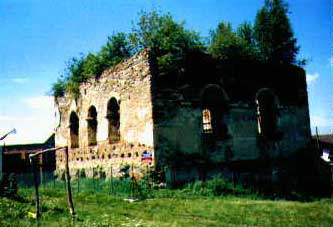
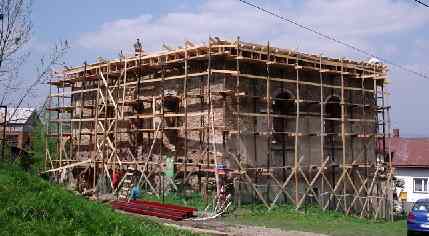
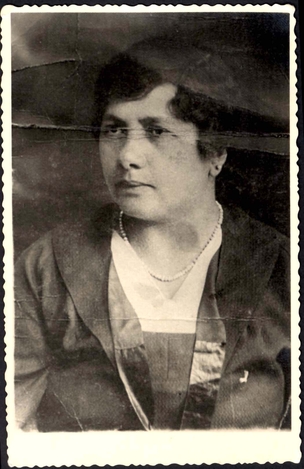
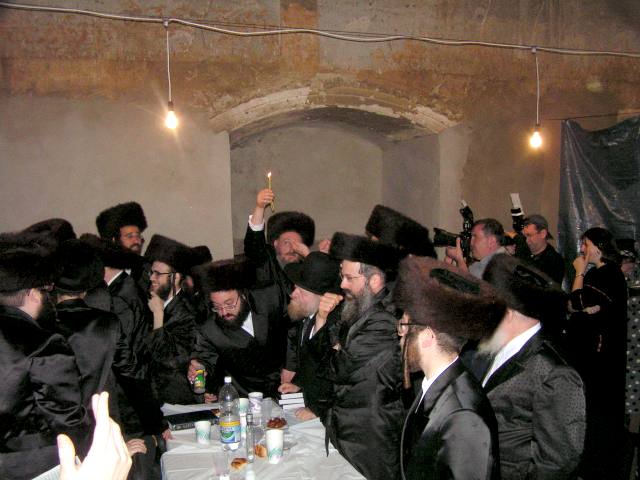 8/06
8/06 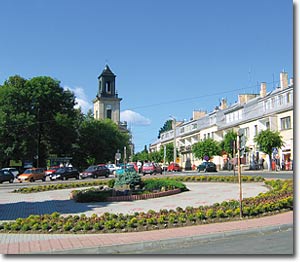

 mar2018
mar2018 May 2017
May 2017 
 Updated Jan 2019
Updated Jan 2019
 10/14
10/14 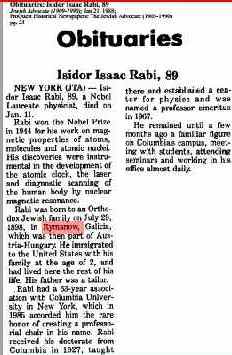
 May
2013
May
2013  including
Yad Vashem, the USHMM, the International Tracing Service,
JewishGen’s Holocaust Database & Global Registry, Yizkor
Books, the Camps & Ghettos, YIVO, Joint Distribution
Committee and the Jewish Historical Institute in Warsaw
including
Yad Vashem, the USHMM, the International Tracing Service,
JewishGen’s Holocaust Database & Global Registry, Yizkor
Books, the Camps & Ghettos, YIVO, Joint Distribution
Committee and the Jewish Historical Institute in Warsaw
![]() Please note: This site exists because of your
Generosity. Your tax deductible donation to JewishGen makes
these services possible. If this site helps your search,
just click on
Jewish Gen-erosity.
Please note: This site exists because of your
Generosity. Your tax deductible donation to JewishGen makes
these services possible. If this site helps your search,
just click on
Jewish Gen-erosity.
Our researcher in Poland has gathered quite a number of
interesting observations about the neighboring town of
Rymanow. The Photographs were contributed by Deb Raff, who
spent a recent summer in the area and Michal Lorenc, who is
working to restore the cemetery. 
History: The Jewish settlement in
Rymanów is very old and important, but not very
well-documented. A synagogue already existed in the 16th
Century. In those times, the Jews of Rymanów traded wine
imported from Hungary, and sold it among others at the
fairs in Krosno. In 1765, approximately 1015 Jews lived in
Rymanów (42.8% of the population). In the 19th Century,
Rymanów became one of the most important centers of
theology and science in Galicia, thanks to the famous Zaddik,
Menachem Mendel (Mendele of Rymanów, died in
1815) who was the pupil of Elimelech of Lezajsk and
Szmelke of Nikolsburg, and the 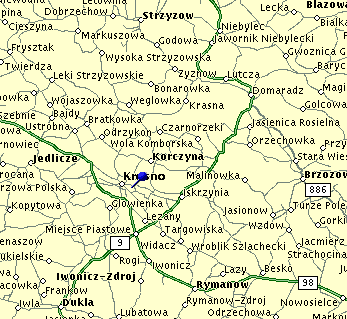 teacher of Naftali of Ropszyce.
teacher of Naftali of Ropszyce.
At the end of the 19th Century, the Zionist movement became active in Rymanów. In 1921, 1412 Jews lived in Rymanów (40% of the population). Shortly after the Nazis occupied Rymanów in 1939, a part of the Jews were driven off to the zone occupied by the Soviets. In 1942 men between 14 and 25 years old were taken to the labor camp of Plaszów. The remaining Jews were deported to the extermination camp in Belzec.
The Synagogue is at the corner of Bieleckiego Street. Built in the 17th Century. Today it is in ruins. (editors note: not so, rad on to see the rebuilding of the synagogue). In the interior 4 columns and remains of frescoes have been preserved.
The Cemetery is on Slowackiego Street, 500 m. from the Market Place. The year of foundation is unknown. Size 2.64 hectares, surrounded by a whitehorn hedge. Approximately 200 gravestones have been preserved, of which approximately 100 in a good state. Recently, two new ohels were built on top of the hill in the cemetery: one in memory of the murdered Jews, the other in memory of the Zaddiks of Rymanów. Mr. Bialas (Grundwaldzka Street), who takes care of the cemetery, has keys to the monuments.
I z b a p a m i e c i (Memory Hall) , Bieleckiego Street 3. A collection of Jewish keepsakes.
The railway station is located in the village of Wróblik
(wonderful old wooden Greek-Orthodox church) - 5 km from
the center of Rymanów (carriage 3 K., seat in cab 40 h.).
(...) The townlet has 3800 inhabitants (1800 Jews) and is
located on a hill. Hotel and restaurant of Marceli
Nadziakiewicz (rooms from 2.40 to 3.40 K.). The
only remarkable thing in Rymanów is the baroque Church
from 1780 with its high tower, founded by the
Ossolinski family. In the chapel a monument in red marble
and alabaster for castellan Jan Sieminski (died 1580) and
his wife. Beside 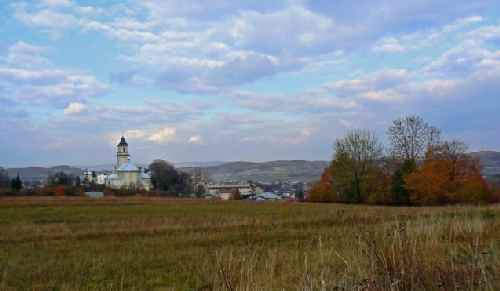 this, Rymanów is
known for its miracle-working rabbi and thus the crowds of
Galician and Hungarian Jews, and for its unpredictable
southern storms ...These gusts of wind -- the so-called
Rymanower winds -- are so strong that they overturn people
and carriages.
this, Rymanów is
known for its miracle-working rabbi and thus the crowds of
Galician and Hungarian Jews, and for its unpredictable
southern storms ...These gusts of wind -- the so-called
Rymanower winds -- are so strong that they overturn people
and carriages.
First mention of and settlement in Rymanów is 1372-1378; located on the former trade route to Hungary. The local Jewish community belonged to the Kahal of Lesko. In the beginning of the 17th Century, the bishop of Przemysl convicted the Rymanów Jews of having profaned the Christian world. In the beginning of the 19th Century, the town became a center of Chassidism. Their seat in Rymanów had Menachem Mendel, pupil of Elimelech of Lezajsk, and after his death in 1815 his pupil, Cwi Hirsz Kohen (died 1846).
The first synagogue was mentioned as early as
1593 . In the same time period, the first
cemetery was created. 
The photographs were donated by Deb Raff; they were taken on a recent trip to the area.
The synagogue at Bieleckiego Street was built
at the end of the 18th C. Although made of
stone and brick, it has steadily become dilapidated since
the end of World War II.. It is located in the town's
center, off the market place, on the slope of a hill. Only
the walls of the main room with its square ground plan of
13.5 x 15 meters, the small round tower on the northwest
corner and a part of the hall on the west side have been
preserved. Inside, in the center of the main room, four
beautifully ornamented brick columns with Corinthian
capitals, spanned by a flattened cupola with fragments of
the vault. In the interior walls a row of arched 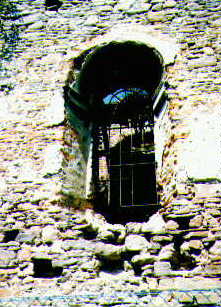 niches beneath the windows;
the niche for the Aron ha-kodesh has been preserved as
well as frescoes from the 20th C. The original shape of
the roof is unknown.
niches beneath the windows;
the niche for the Aron ha-kodesh has been preserved as
well as frescoes from the 20th C. The original shape of
the roof is unknown.
The following is the Jewish population, as it appeared in
the long history of Rymanow:
1765 - 1015 Jews
1880 - 1391 Jews = 42.6% of the population
1900 - 1746 Jews = 46.9% of the population
1910 - 1739 Jews = 46% of the population
1921 - 1412 Jews = 39.9% of the population
In August, 1942, the ghetto was established. The majority
of the imprisoned Jews were deported to the extermination
camp of Belzec, others were murdered in the ghetto and in
the woods of Barwinek.
The above was translated August, 2000, under the auspices of the Zmigrod Nowy Research Group
Return to Rymanow's Table of Contents
The 1929 Business Directories for all the towns in
galicia are available for viewing on JewishGen. 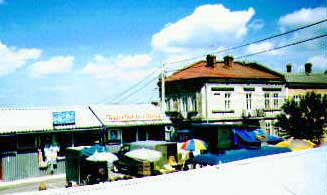
The following is an alphabetic list of the names in the
Rymanow section: Bart, I; Beer, E; Beil, M;
Berger,E; Berglas, S; Bertenthal, B;Bialas,A; Boblik,
T; Bodenstein; Braun, E; Bucher, J; Bucher, S.W;
Dankiewicz, W; Einhorn, J; Engelhardt,E; Englehart, J;
Etra, B;
Fass, B; Feasel, S; Fischel and Wolf; Fluhr,R;
Frankel, H; Frenzel, S.; Freund, E; Funfer, J.;
Furst,L;
Glazer, S; Gold, S; Gotzler, O; Gunsberg, S;
Haladewicz,; Halpern, J; Hirschfeld, D ; Horowitz, M ;
Jakubowicz; Katz,S; Keler, M; Keller, C; Keller, N;
Kilar,J; Konig, I;
Landau, M; Leckar, M; Leib, I ; Lejhowicz; Low, M;
Maj, A; Mandel, M; Mann, A; Mayer, J; Meller, M;
Moszkowicz, D;
Perl, C; Pile, B; Pinkus, B; Pistrag, M; Pulnar, S;
Riff, R; Robinson, H; Romm, N; Rosen, S; s
Schachter,S; Schiff, M., Dr.; Schimmel, S; Schreiber,I
; Shamroth; Sherer, J; Silberman, J; Soltysik, J;
Sponder, H; Stary, A; Stern, J; Stoff, M; Stutzel, I;
Teig, R; Tenenbaum, S.; Wald, J; Weinberger, Ch;
Weitmann; Wimmer, Ch., Dr.; Wolf, A; Wolf, H; Wolf, M;
Zywicki;
If you wish to view the directory, click here and key in the name of your town.
Return to Rymanow's Table of Contents
The following list of current Galician records
was taken from the wonderful guidebook
"Jewish Roots in Poland: Pages from the Past and Archival
Inventories" by Miriam Weiner:
Rymanow, which was in Krosno, now in Podkarpackie Province:
In February of 2018 i received this email: with these
abstracts of vital records from the early 1800s! These
abstracts were gotton in 1992 by mail from the USC in
Rymanow. We're not sure, but perhaps the Jewish records
were mixed in with others?
The first is a birth record registered in 1807 for Chaim
Torem, son of Pinkas Torem and Sara Rek. The second is a
marriage record registered in 1824 for Chaim Torem and
Estera Fishel (daughter of Markus Fishel and Mindla
Goldstein). 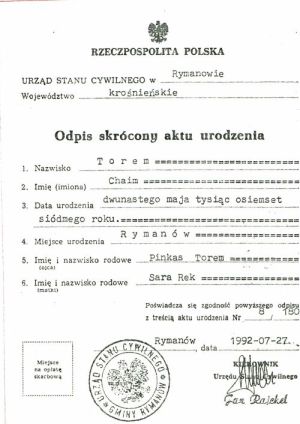
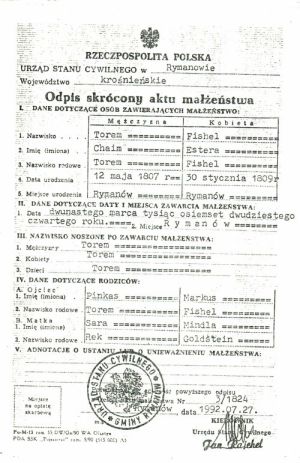
The 1891 Galician Business Directory contains 110 listings for Rymanow:. Surnames include:
The 1891 Galician Business Directory contains many listings for Rymanow. JewishGen has combined this database with many other databases and you can access them with one query. Click here and then go to the Polish Databases (but don't forget to return here after you are finished). Key in your surname or key in the town (Rymanow) at: The JewishGen Polish Databases
Return to Rymanow's Table of Contents
Once the immigrants arrived in the United States, they often banded together for mutual assistance purposes. It was also quite typical of the Landsmenshaften to own common cemetery plots. The Rymanower Young Mens Benevolent Society owned two Landsmanshaft plots in the New York City area. They are listed on the New York Jewish Genealogical website. The plots are located at Mt. Hebron (path 32, gate 2) and Mt. Zion (Block 75, path 1).
I do not believe that this society is still in existence. But, if you have any information about the society or a cemetery plot, please contact Jeff Alexander.
Return to Rymanow's Table of Contents
You can query the Mount Hebron Cemetery database either
by surname or by town name. Click on the link below and
enter Rymanow in the "society" box. You'll find there
are 620 listings for the Rymanower Young Mens' Society.
(Don't forget to click your back arrow, when you are
finished, so you can come back to this web page). The
link is:
http://www.mounthebroncemetery.com/search.asp?type=interment
Return to Rymanow's Table of Contents
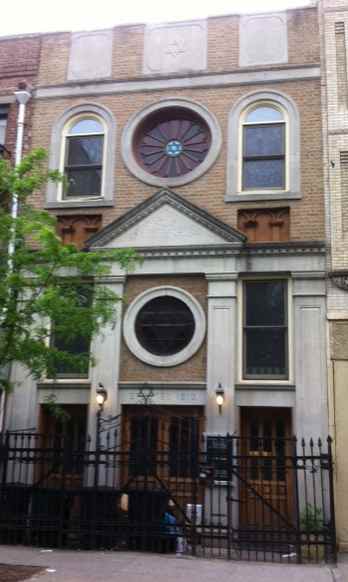
We received this message in October of 2004 from Jonathan Boyarin, and we pass it along to you. "I saw your page about Rymanow on the JewishGen website, and thought you'd like to know that our synagogue, the Stanton Street Shul, has a historical connection to the Bluzhower-Rymanow society, which may be a succesor to the Rymanow landsmanshaft you refer to on the website.
Although the congregation is officially known as Congregation Anschei Brzezan, the Bluzhower-Rymanow society paid "rent" for decades to join in the services, and that relationship was never terminated, though at most one or two members of that society are still at the shul. I believe as well that one of our elder congregants either was born in Rymanow himself, or has parents from Rymanow. You can learn more about the shul at our website: www.stantonstreetshul.com, and are of course invited to visit us if you are ever in New York. "
Subsequently we received this note from Barbara Cohen Pollak: "My son recently became the Rabbi of the Stanton Street Shul on the Lower East Side. Talking to the 90-year-old president, Bernie Sauerhaft, revealed that Rymanower YMB had merged at some point, along with several other Galician landsmanschaft, into Stanton Street Shul. The Hanging beside the Ner Tamid is also one from the shul in Rynanow."
In 2011 after contacting Rabbi Josh Yuta, I was linked
to the resident historical expert, Elissa Sampson; who
led me to a collection of documents and photographs
(http:>
https://picasaweb.google.com/ejswoo/StantonStreetShulHistoricDocuments#541598227279662).
Elissa was kind enough to allow me to use some of those
documents and photographs 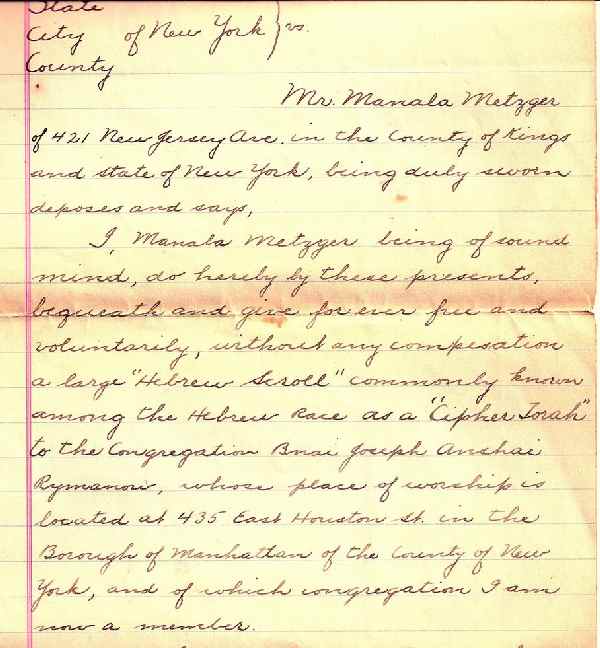 pertinent to
the Shul and Rymanow. This is a great example of
constructive partnership of JewishGen's Kehilalinks and
a local on-the-ground Shul with Rymanow connections. It
gives international publicity to this wonderful
community while at the same time, affording a
information for folks researching their Rymanow roots.
pertinent to
the Shul and Rymanow. This is a great example of
constructive partnership of JewishGen's Kehilalinks and
a local on-the-ground Shul with Rymanow connections. It
gives international publicity to this wonderful
community while at the same time, affording a
information for folks researching their Rymanow roots.
Located at 180 Stanton Street, this Shul has quite a history. It began with Congregation Bnai Jacob Anshe Brzezan (“Sons of Jacob, People of Brzezan”), a shtetl in Southeast Galicia (now the Ukraine). In 1952 the congregation merged with the joint congregation Bnai Joseph Dugel Macheneh Ephraim; DME, as it was known, represented the shtetls Rymanow and Blazowa in southwest Galicia. Today these two shtetls are in Poland.
The Stanton Street Shul is one of only a few early synagogues that have survived; a veritable landmark of the Lower East Side. More history and information about this shul is on their web site http://www.stantonstshul.com/ and they are very welcoming to visitors!
For Rymanow, there is a wonderful treat; one of the
original Torahs from Rymanow is at the Stanton Street
Shul today. At the right is a notarized 1915 letter that
shows a donation of a Sefer Torah (a Torah scroll) by
Mrs. Manala Metzger to the Riminver congregation, Bnai
Joseph Anshei Rymanow at 435 East Houston Street, NY.
Some other interesting documents include the Brzezan Constitution and the Brzezan Incorporation certificate, which names the original members:

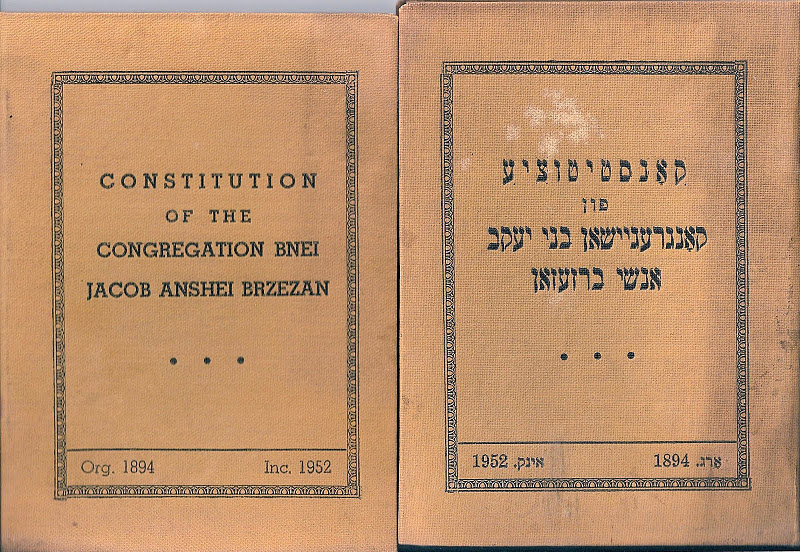
In In 1952 the joint congregation Bnai Joseph Dugel
Macheneh Ephraim merged with the Congregation Anschei
Brzezan. In 1965 David Weissman was President and
Abraham Geller was Treasurer. The 1965 dues statement of
$1.75 for 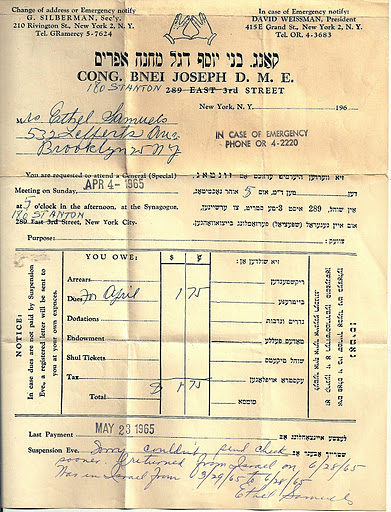 Esther Samuels of 532
Lefferts Blvd in Brooklyn, shows that Congregation Bnai
Joseph D.M.E. moved from 289 East 3rd, to 180 Stanton
Street, where they merged with Bnai Joseph Anshei
Brezan.
Esther Samuels of 532
Lefferts Blvd in Brooklyn, shows that Congregation Bnai
Joseph D.M.E. moved from 289 East 3rd, to 180 Stanton
Street, where they merged with Bnai Joseph Anshei
Brezan.
Some of this information came from the Landsmanshaften
of New York, a work produced by the WPA in 1938.
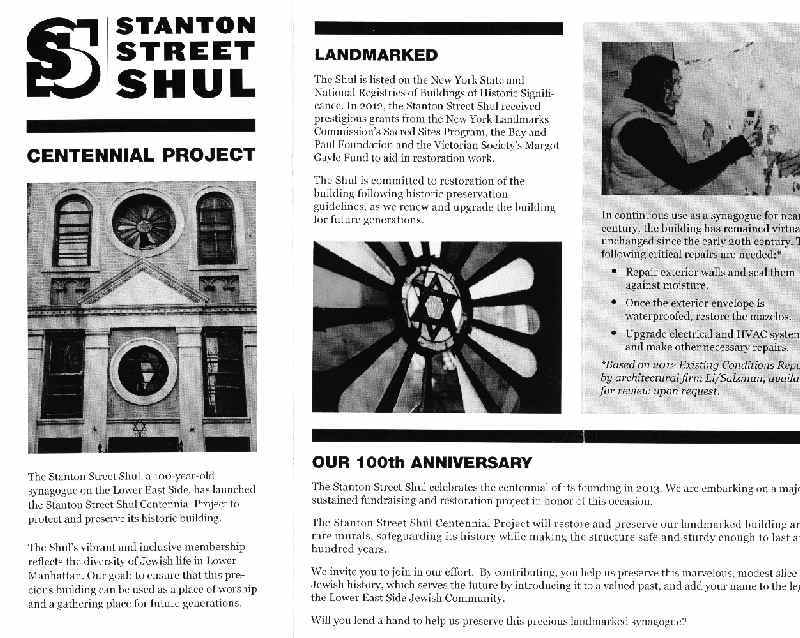
The rules of the Chevrah Kadusha of the Rymanower
group, Congregation Bnai Joseph DME (Dugel Machine
Ephraim): 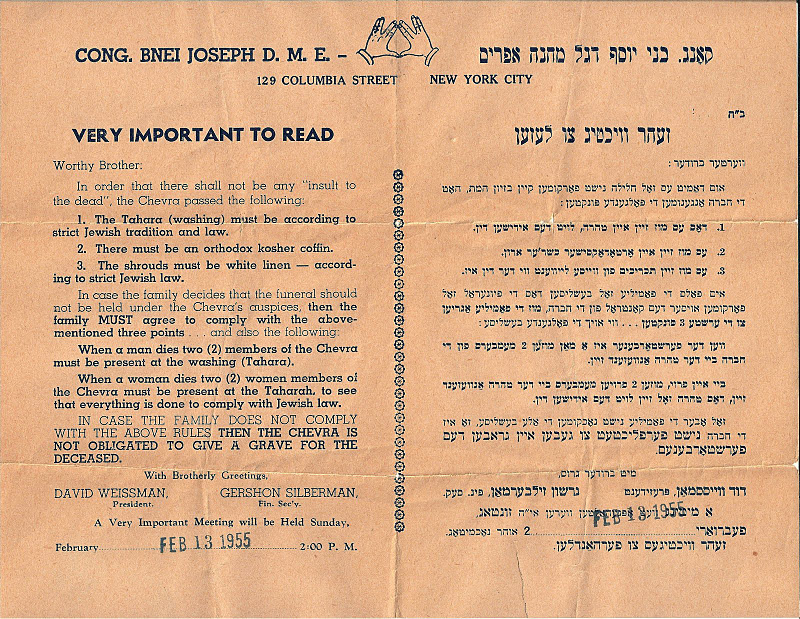
Credit to the Stanton Street Shul, for these wonderful documents and photographs above.
Return to Rymanow's Table of Contents
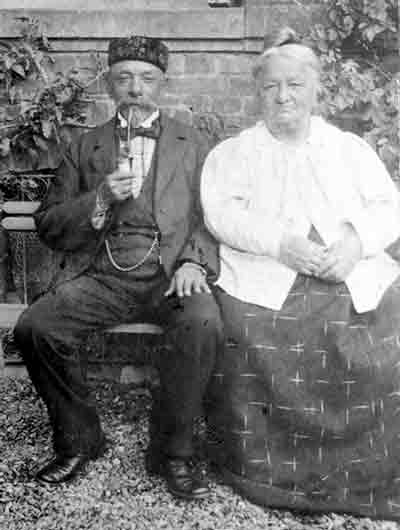
My great grandfather Albert LAUTMANN was born in Rymanow in 1827. His parents ,were Israel and Esther Lautmann. The photograph at the right show Albert (1829-1902) and his wife Cypresse Ortner (1832-1917), who was born also in Galicia. Unfortunatly I don't anything about his life in Rymanow.
My great grandfather left Rymanow and his children
were born in Brafla (Romania) where the family lived
until 1880. Then they moved to Vienna in Austria and
finally to Paris, France where my grandfather Andre
Lautmann was born. For more information, please
contact Pierre
Lautmann, Vincenne, France
My grandfather, Abraham WILNER emigrated in
1904. He was followed by his brothers Samuel and
Solomon, mother Chane & sister Rose. They all went
to uncle Livish & Rose Wilner on East 3rd Street in
New York City. I've gone back as far as my great great
grandfather, but I don't know if he had brothers or
sisters. I'd like to hear from other Wilner descendents.
Gary Wilner
Dear All,
My great-aunt Pesia SINGER lived in Rymanow, Poland
before WW2 and took care of my mother when she (as a
young child) spent her summers there. My grandfather
Leon, Pesia's brother, had died of peritonitis shortly
before my mother was born. My mother told me that Pesia
lost her son and husband when they were executed by the
Nazis, but survived the war and subsequently moved to
America, however she knew no other details, and I have
been unable to track Pesia or any surviving family. Some
months ago, I was contacted by Malka Shacham Doron,
whose mother Frida Stary knew Pesia when they were
young, and had met Pesia in Israel after the Six Day
War. Malka extracted details from her mother's diary and
sent me the following information: Pesia Singer married
Shmuel SHTOFF (from Sieniawa, Poland). They had two
children - a girl named Lucia born 1929 and a boy named
Ideck (Yehuda) who was born later. Shmuel became the
chairman of the kehilla in Rymanow. After the Germans
occupied Rymanow, Shmuel was asked by the Germans to
give them a list of young men from Rymanow to do
physical labour. He refused and was taken to the school
yard at Bieletzky street (near Bielecki's house)
together with his son Ideck. Shmuel wrapped both his son
and himself with a tallit and both were shot to death.
(March 1941). The perforated tallit still exists and is
kept in (Ignacy) Bielecki's Judaica collection in
Rymanow. Pesia buried some of her jewelry in the garden
and took Lucia from home and fled that night from
Rymanow. She hid Lucia at the home of their Christian
maid in a small village near Krakow. Pesia turned a
beggar, and for almost three years she sat next to
Kosciol Mariacki (St. Mary's Basilica) in Krakow, where
a priest allowed her to sleep inside the church at
night. Towards the end of the war as the Russians were
nearing, a Polish man from Rymanow who came to Sunday
mass at the church recognized her. She immediately fled
Krakow and went to the village where Lucia was and
fetched her. During the last battles between the
Russians and the Germans she arrived at Rymanow. She dug
up the jewelry she had hidden and later settled in
Sanok. Pesia was one of the first survivors and hosted
many Jews from Rymanow that arrived later from various
concentration camps. Later, Pesia immigrated to Canada
with Lucia.
A harrowing story, which I felt I must share - Pesia was both brave and lucky. It gives me hope that 1) I might be able to track Pesia in Canada (where I live!); 2) Lucia might still be alive and 3) that some of those who survived the camps and visited Pesia in Sanok might have passed on some memories. I wonder if any 'Genners' might have some information. David Scriven.
Return to Rymanow's Table of Contents
Meet Meier Kornreich, born in Rymanow in 1910; his parents were Josef KORNREICH and Malka STECHER. Malka, who was my grandmother's sister, was born in the nearby town of Zmigrod (to view the KehilaLinks site for Zmigrod, click here) to Leib STECHER and Golda TRACHMAN. Tragically Malka died young, after having 6 children: Schmiel (Sam), Moshe (Morris), Zlater, Zvi and Golda. Max told me many stories about his youth in Rymanow and some I'd like to relay.
"I don’t remember my mother; I must have been 3-4 years old [when she died]. When I was a child a few years old I had to go every day walking 5 o'clock in morning to the farmer, 3-4 miles, to deliver milk to the city. The farmers were nicer to me than the Jewish customers [they always complained]...milk late, cold etc; they would take me in by the fire. After my mother died, (after WWI), my older sisters were mostly interested in matchmaking. I was afraid they’d send me to the orphan home. [Zlater Kornreich married Samuel MAY, and had two children, Lourk and Malka, but tragically they all perished in the holocaust; the rest of the Kornreich family survived, although their experiences were dreadful; their descendents live today in Israel and the U.S. Some were present in the Rymanow remembrace day detailed on this site.]
At 7 I left the house, bummed a ride to Zmigrod; went
to live with my grandfather Lieb [STECHER]; I remember
Lieb sent me into Zmigrod to the slaughter house with
many chickens, but I didn’t know where it was. Leib's
grandchildren were older; I remember [my aunt] Scheindel
who was very kind [the tree is below]; After a few weeks
went to live with the Blanks (they had pretty daughters)
in Dembovitz near Jaslo [Zelda STECHER married Aaron
BLANK]; they treated me well, but she had her own
children. They took me to Jaslo and gave me a ticket to
Rymanow. 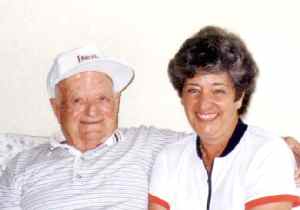
At 14 years old I went by train to Germany (Frankfort an Maim- a beautiful city) to join my brother Schmiel who was running a religious school; only had the address written down. But I didnt like religious school (we studied the bible), and only went because they gave me breakfast. At 15 years I left to Antwerp Belgium, with no money. Slept on floor of a friends house; they offered me a job with no wages, and sleeping in kitchen. I got rheumatism from that stone floor in the garage. My sister wrote suggesting I go to Vernich which has famous baths for your rheumatism. Returned to Belgium. Wanted to learn trade; in belgium law says must pay workers. I was 20/21, and i met and married Clara Lieber; I knew her mother and family well.
I was always fond of swimming; I came to Daytona 15 years ago because I heard of the 36 mile beach. I've been here ever since."
The photograph of Max and I was taken in 1997.
To view the complete family tree, click
here
Phyllis Kramer, updated July 2011
Return to Rymanow's Table of Contents
Virtually all of the Feit families who immigrated to the United States since the mid-1880s from Austria /Poland are Jewish and originated from about 73 villages and towns in the southeastern corner of Poland. Most of these villages are clustered around Brzozów, Sanok, and Krosno and extend northward for about 60 miles along the River San – including Przemysl (near the border with Ukraine), Lezajsk, Rudnik, Nisko, Tarnobrzeg, Rozwadów and Radomysl – to where it meets the River Wisla at the former northern border of the Austrian province of Galicia. Other Feits branches stem from Rymanow and Jasienica Rosielna.
Galician Jews adopted fixed hereditary surnames after the 1787 law of Kaiser Joseph II. Based on data extracted from hundreds of documents and databases, marriage and death certificates, naturalization records and information from Feit descendants, I have been creating family trees and searching for common ancestors to link together as many branches as possible. With a focus on older generations, my file now contains more than 8,000 individuals, with many name duplications, in 380 unconnected branches. The earliest known birth date is 1800 (Jacob Feit) and more than 1,500 individuals have known or estimated birth dates before 1900. Additional clues from descendants and Polish records are needed to merge more branches.
The tree of the Feit brothers Isidore and Jacob from Krosno, Rymanów, Trzesniów and Brzozów contains 399 individuals. Two FEIT FamilyTree Project reports are available upon request. The database contains more than 1,200 different surnames. A FEIT Family Photo Album was also created.
For more information, please email me by clicking my
name,
Bette Stoop
Mas
December 2013
Return to Rymanow's Table of Contents
Ellis Island has an online database and our friend Steve Morse created a query at www.jewishgen.org/databases/EIDB . Here are the steps:
The following is a list i compiled from Steve Morse’s
query; it represents the index of passengers who arrived
at Ellis Island between 1892 and 1924. The information
contained is:
SURNAME, FIRST NAME, SHTETL, COUNTRY, YEAR OF
EMIGRATION, AGE
 Happy hunting!
Happy hunting! And in 2017 i finally got the cadastral map from the same period, so now we can associate the house numbers with the occupants below.
Alphabetisches Verzeichniss der Gemeinde Stadt
RYMANOW Bezirkhauptmanschaft Dukla Steuramt Rymanow
1852
Geometer IV K1asse Joseph Kaner verfasst vom Adjunkten
II Klasse Wenzel Arbeiter
This was translated as: The Galician Crownland. An alphabetical index of the municipality of Rymanow, in the Dukla District, tax department of Rymanow from 1852; Geometer(?) Class IV of Joseph Kaner. Created/sponsored/composed? by the Associate second class Wenzel Arbiter.
F1#-- Haus#-- Name-- Baup # --Grundp #--Sect.
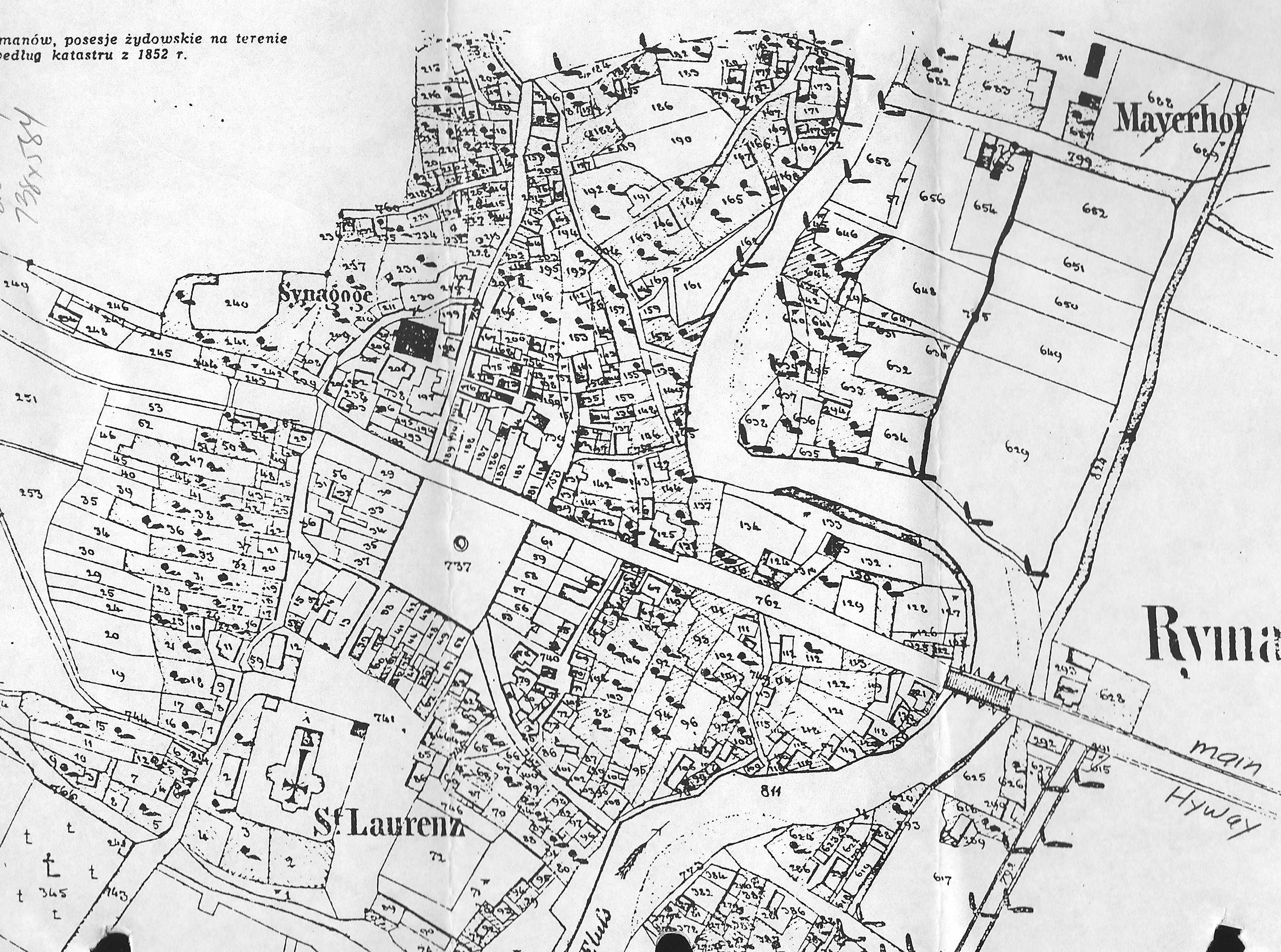
Return to Rymanow's Table of Contents
Rymanów – A list of shops, service agencies, warehouses and wholesalers in the Jewish Rymanow, as of September 1, 1939 sourced from: http://www.sztetl.org.pl/en/article/rymanow/10,people-lists-of- names-genealogy/9495,a-list-of-shops-service-agencies-warehouses- and-wholesalers-in-the-jewish-rymanow-as-of-september-1-1939/
There were 117 shops, of which 38 were in the marketplace, 10 shops were in Kosciuszko Street and 14 were on Piekarska Street. In total 117, of which there were 38 in the marketplace:
This is the unalphabetized list...but it shows the location; You can use edit/find if you wish to search for a particular suname.

Return to Rymanow's Table of Contents
While googling the internet for Rymanow, a friend came across the weekly lists of 1893 cholera epidemic victims; the lists indicates their towns, names, ages, occupations, the date when they contracted cholera, and date of death. The death date was left blank, unless the person succumbed to cholera. This is only a small sample of 6 weeks; there were many more pages on google, but unfortunately they are no longer available.
| Date | Surname, First Name | Age | Beschaftigung (occupation) | Date of Death |
| Sept 20 | San, Toire | 39 | Taglohner | Sept 23 |
| Sept 22 | Schreiber, Marcus | 7 | Handlessohn | |
| Sept 22 | Liff, Reisla | 11 | Schneiderstochter | |
| Sept 22 | Tobias, Hanne | 12 | Fassbinderstochter | Sept 23 |
| Sept 22 | Teig, Raphael | 17 | Schneiderssohn | |
| Sept 22 | Liff, Alte | 35 | Schneidersfrau | |
| Sept 22 | Sprinze, Joel | 18 | Trodlersfrau | Sept 25 |
| Sept 22 | Bucher,Moses | 11 | Fleishhauerssohn | Sept 24 |
| Sept 22 | Herrschale, Leisla | 17 | Tochterein Hockerin | |
| Sept 23 | Sand, Rachel | 25 | Taglohneria | |
| Sept 20 | Bialas, josefine | 22 | Schusterstochter | |
| Sept 22 | Bialas, Julie | 28 | Schusterstochter | |
| Sept 22 | Rosen, Israel | 8 | Kramerssohn | |
| Sept 22 | Sponder, Choje | 8 | Schneiderskind | |
| Sept 22 | Steciak, Dominica | 20 | Naherin | |
| Sept 22 | Bier, Chile | 40 | Fleischhauersfrau | |
| Sept 22 | Bier, Esther | 3 | Deren kind | |
| Sept 22 | Naftali, Elias | 60 | Bettler | Sept 25 |
| Sept 22 | Blumbenfeld, mortko | 3 | Bettlerskind | |
| Sept 22 | Spira, Blume | 2 | Mehhandlerstochter | Sept 25 |
| Sept 23 | Kirepski, Johann | 11 | Wassertragerinssohn | |
| Sept 20 | Jakubowicz, Salomon | 12 | Uhrmachersohn | |
| Sept 22 | Sponder, Israel | 3 | Schneiderssohn | |
| Sept 22 | Kindlilk, johann | 65 | Wasserager | Sept 25 |
| Oct 3 | Lichtzieher,Race | 5 | Handlerinstochter | |
| Oct 3 | Heller, Malka | 14 | Kaufmannstochter | |
| Oct 3 | Fessel, Reisle | 3 | Kaufmannstochter | |
| Oct 3 | Fessel,Chaja | 28 | Kaufmannfrau | |
| Oct 3 | Sann, Ides | 8 | Klampnerstochter | |
| Oct 4 | Fraeczek, Josef | 4 | Schusterstochter | Oct 4 |
| Oct 4 | Debiec, Victoria | 25 | Naharin | |
| Oct 4 | Kratzer Samuel | 21 | Backergeselle | |
| Oct 5 | Bobek, Toibe | 17 | Backergeselle | Oct 9 |
| Oct 6 | Liff, Josef | 6 | Schneiderssohn | |
| Oct 17 | Nachurska, Josefa | 34 | Schustersfrau | |
| Oct 18 | Jachimowska, Maria | 9 | Maurerstochter | Oct 19 |
| Oct 20 | Schachner, Freide | 4 | Regenischermine-tochter | Oct 22 |
| Oct 22 | Hammel, Naftalia | 50 | Getreidehandlerin | Oct 23 |
| Oct 24 | Urbankik, Peter | 4 | Wassertrager | |
| Oct 24 | Schachne, Chaie | 6 | Regenischermine-tochter | |
| Oct 25 | Chane, Ella | 29 | Holzhandlerstochter | |
| Oct 25 | Reis, Eva | 17 | Dienstmagd | |
| Oct 27 | Dankiewicz, Kathrina | 32 | Schustersfrau | Oct 28 |
| Oct 27 | Dankiewicz, Julie | 2 | Schusterstochter | |
| Oct 29 | Weinstein, Cal | 5 | kaufmannssohn | |
| Sept 26 | Glaser, Maria | 29 | Glassersfrau | |
| Sept 26 | Sand, Eittel | 60 | Taglohnerin | |
| Sept 27 | Bodenstein, Jacob | 9 | Backerssohn | |
| Sept 28 | Bobik, Samuel | 55 | Fiaker | Sept 28 |
| Sept 28 | Solecki, Andreas | 48 | Kurschner | Sept 29 |
| Sept 28 | Solecki, Stanislaus | 7 | Dessen sohne | Sept 28 |
| Sept 28 | Solecki, Josef | 16 | Dessen shone | |
| Sept 28 | Hule, Fluhr | 3 | Taglohnerstochter | Oct 1 |
| Sept 28 | Lorenz, Maria | 25 | Hauerin | Sept 28 |
| Sept 29 | Piwowa, Andreas | 29 | Taglohnerin | |
| Sept 26 | Eidelbaut,Esther | 15 | Naherin | |
| Sept 26 | Lichtzieher,Gittel | 9 | Handlerinstochter | |
| Sept 27 | Henze, Joel | 5 | Trodlerstochter | |
| Sept 28 | Bolanowska,Julie | 6 | Taglohnerstochter | |
| Sept 28 | Schreiber, Blume | 48 | kaufmanskinder | |
| Sept 28 | Weinreb, grabel | 10 | kaufmanskinder | |
| Sept 28 | Weinig, Race | 15 | Kaufmanskinder | |
| Sept 28 | Weinig, Moses | 3 | kaufmanskinder | |
The American Jewish Joint Distribution Committee (JDC) was active in Eastern Europe during the 20th century. Recently the JCC has put its archives online. When you do a search at http://archives.jdc.org/archives-search/, the following surnames come up for Rymanow:
![]() click to return to the
JewishGen Home Page Please
note: This site exists because of your Jewish
Gen-erosity. Your tax deductible donation to JewishGen
makes these services possible. We spent a great deal of
time organizing this information so that your
genealogical search might be more rewarding....and you
can reward us -- just click on
Jewish Gen-erosity.
click to return to the
JewishGen Home Page Please
note: This site exists because of your Jewish
Gen-erosity. Your tax deductible donation to JewishGen
makes these services possible. We spent a great deal of
time organizing this information so that your
genealogical search might be more rewarding....and you
can reward us -- just click on
Jewish Gen-erosity.